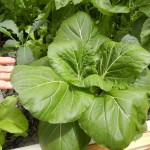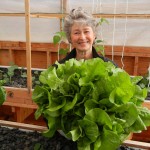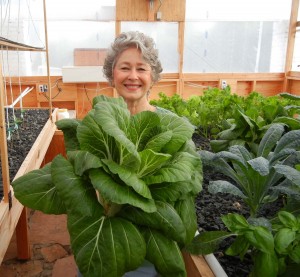Portable Farms® Aquaponics System Course© through Aquaponics University
NOW OFFERED ONLINE in a self-paced course.
 After completing the Portable Farms® Aquaponics System Course© satisfactorily online, we will ship you the Portable Farms® Kit so you can build your own Portable Farms® Aquaponics System to feed your family FOREVER. The Portable Farms® Kit is included in the price of the course.
After completing the Portable Farms® Aquaponics System Course© satisfactorily online, we will ship you the Portable Farms® Kit so you can build your own Portable Farms® Aquaponics System to feed your family FOREVER. The Portable Farms® Kit is included in the price of the course.
If you want to build your own backyard farm to feed eight people or less, you’ll need to take our ONLINE Portable Farms® Aquaponics System Course© FIRST. The Portable Farms® Kit is part of the course. After completing the Portable Farms® Aquaponics System Course© satisfactorily, we will ship you the Portable Farms® Kit so you can build your own Portable Farms® Aquaponics System. Please note: The ONLY way to purchase the Portable Farms® Kit is by taking the Portable Farms® Aquaponics System Course© FIRST. Our price for the Portable Farms® Aquaponics System Course© which includes the entire assembly, operations and maintenance course.
COURSE OUTLINE
Portable Farms® Aquaponics System Course©
Below is an outline of the 26 sections (A-Z) included in the Portable Farms® Aquaponics System Course© designed for training people to assemble, operate and raise healthy organic vegetables and aquatic animals (fish) in the Portable Farms® Aquaponics Systems through Aquaponics University, a wholly-owned training division of PFAS LLC.
Section A: Preface to coursework and overview with images for main components of the aquaponics system
- Easy formulation for sizing needs based on number of people the aquaponics system will feed.
- Calculation for determining the size required for the fish tank.
- Grow lights for structures, locations or areas with limited available sunlight.
- Overview for an acclimatized greenhouse structure for year-round growing in an aquaponics system.
Section B: Overview and images of the interior of aquaponics system
- Explanation of the components that are incorporated into the aquaponics system for easy care.
- Ratios for grow space vs gallons of water required for an efficient aquaponics system.
- Recommendations for sunscreen protection for interior of structure (greenhouse).
- Determination for required feet ‘head room’ above grow trays for maximum plant production.
Section C: Terms and definition regarding the aquaponics system
- Terms and their definition that are used in the coursework, assembly and operations.
Section D: Site requirements for the aquaponics system
- Considerations prior to the installation of the structure (greenhouse).
- Suggestions for basic requirements regarding installation of grow trays, air flow within the structure and alternative energy.
Section E: Materials lists and cost estimates for assembly of the aquaponics system
- Materials lists and US prices (approximate) for lumber, fish tank, fish and other pertinent supplies and materials.
- Suggestions regarding the purchase of a breeding colony for aquaponics.
Section F: Assembly of clarifier (settling tank) as component of the aquaponics system
- Explanation and basic operation of clarifier.
- Location, requirements, drum, PVC fittings, and proper plumbing of clarifier.
Section G – Fish tanks and introducing the fish into the fish tank in the aquaponics system
- The formula for the volume (size) of the fish tank.
- Fish recommendation.
- Recommended maximum loading capacity of the fish in relation to the size of the grow tray.
- Water temperature maintenance and insulation designs for maintaining recommended narrow temperature range for maximum fish health.
- Building a tank to protect the fish and maintain temperature range.
Section H: Assembly of grow tray tables in the aquaponics system
- Directions for building and waterproofing methods for grow tray.
- Examples for assembly of sturdy legs to support the weight of the grow tray.
- Plumbing the grow tray for effective water flow to feed and water plants.
- Effectively installing medium into grow tray.
Section I: Explanation of required necessary electrical components in the aquaponics system
- List of electrical components, their function and installation
Section J: Calibrated Air Displacement (CAD) pump in the aquaponics system
- Explanation, images and installation of the CAD pump.
Section K: Plumbing the aquaponics system for water flow in the aquaponics system
- Instructions for connecting all the basic elements of the system together with PVC pipe.
Section L: Conclusion to assembly section for the aquaponics system
Section M: Basic operations of the aquaponics system
- Information overview regarding the yields, care of plants and fish and the water in their tanks.
Section N: The fish and the support of their health and growth in the aquaponics system
- Reasons for use of a variety of all-male fish in aquaponics.
- Feeding and care of the fish in the tanks.
- Restocking fish after harvest.
- Discussion for use of duck weed and suggestions and resources for raising duck weed for feeding fish.
Section O: Pumps in the aquaponics system
- Overview and installation of pumps for moving water through the system.
Section P: Climate and weather specific operations and emergency solutions (due to power failure) in the aquaponics system.
- Operating the system during normal weather conditions, hot conditions, cool or cold conditions and during emergency situations (power outages).
Section Q: The operations and cleaning of the clarifier in the aquaponics system
- Directions for routine cleaning and disposal of the fish waste.
- Maintenance of the clarifier for keeping the fish healthy and the plants happy and well fed.
Section R: The grow tray table and your plants in the aquaponics system
- Vertical growing and trellis design features in the grow tray for maximum support of the growth of tall green plants or blooming plants.
- Safety and hygiene issues for aquaponics that are vital to health of fish and plants.
- Plant and harvest suggestions for maintaining optimal growth in the grow tray.
- Care and cleaning of the areas around the grow trays to maintain as clean an interior structure as possible for maximum healthy, safety and productivity of both plants and fish.
Section S: Seed planting and harvesting in the aquaponics system
- Use of mineral rock dust when planting and growing all plants to support maximum growth.
- Suggestions for organic growing mediums for planting seeds.
- Seed and variety suggestions for growing greens and blooming plants.
- Planting and caring for plants in the grow tray.
- Indoor pollination suggestions.
Section T: The physical structure for the aquaponics system
- Recommendation for a greenhouse cover that offers 83% diffusion for scattering light within interior of structure.
- Sun shade for interior of structure.
- Advantages for greenhouse structure
- What NOT to do regarding physical structure.
Section U: Fish harvesting and restocking methods in the aquaponics system
- Recommendations for harvesting only the fish in the tank that are harvest size.
- Suggestions for creating minimal stress on the smaller fish that remain in the fish tank that were not harvested.
Section V: Fish processing and cooking freshly harvested fish in the aquaponics system
- Humane way to fill fish.
- Easy way to gut fish.
- Simple way to fillet fish.
Section W: Ongoing operations of the aquaponics system
- Recommended daily ‘chores’ for raising plants and fish.
- Normal maintenance issues related to the gravel, fish tanks, clarifier for maximum production.
- Routine cleanliness-related topics for healthy food and fish.
- Methods for monitoring plants to assure no insects impact food within the structure.
Section X: Food safety and technology on-farm food safety in the aquaponics system
- Good food practices on aquaponics farm offered by a major US university related to the following basic sanitation procedures to significantly minimize risks.
- Key areas of food safety considerations in aquaponics include human sanitation, harvesting produce safely, managing warm-blooded animal feces, water sources for fish and produce, zoonoses prevention and disposing of the system’s waste water.
Section Y: Guidelines for growing health plants and fish in the aquaponics system
- Worm casting tea as a foliage spray for enhanced plant health
- Smoking prohibited due to Tobacco Mosaic Virus
- Monitoring and adjusting pH balance to assure plant health and productivity as well as fish health and safety.
Section Z: Recognizing pests (bugs/insects) within the aquaponics system
- Simple organic solutions for ridding pests from the structure.
- Recommendations for protecting structure from pests.
Payable by PayPal, Master Card or Visa, or Wire Transfer
Most graduates complete this Portable Farms® Aquaponics System Course© in less than two weeks by working on the course only ONE hour per day and after graduation, build their own aquaponics system! Enroll today! HAVE SOME FUN & GROW YOUR OWN FOOD!
Now you can learn to build your own aquaponics system with an easy to follow self-paced online aquaponics course. Begin your training anytime and take all the time you need to complete the course. It’s a FUN course with easy-to-follow chapters and hundreds of images that show and demonstrate you how to build your own backyard aquaponics system.
Payable by PayPal, Master Card or Visa, or Wire Transfer
Portable Farms® Online Aquaponics Course© includes the following components:
- Introduction to an enclosed greenhouse aquaponics systems
- Methodologies for constructing or purchasing a fish tank from a wide variety of materials depending on locally available materials
- Definition of aquaponics terms
- Materials and construction for your Portable Farm
- Grow tray construction and operations for growing greens and blooming plants in your aquaponics system
- Fish Tanks – temperate and climate requirements
- Tropical climate requirements for fish and growing plants and other weather specific operations
- Installation and operations for the calibrated pumping systems that removes fish waste from the fish tank
- Basic operations of your aquaponics systems
- Fish and the support of their health and growth in your Portable Farm
- Air and water pump operations for moving water through your aquaponics system
- Clarifier and waste removal of fish waste from your aquaponics system
- Seeds and planting in your Portable Farms™ Aquaponics System
- Fish harvesting in your aquaponics system
- Ongoing operations tasks and simple daily chores and maintenance in your Portable Farm
- Food safety and technology – on-farm food safety when growing food in aquaponics
- Macro and micro nutrients for plant growing, blossoming and health of all of your plants and fish
- The impact of tobacco mosaic virus in aquaponics
- Adjusting pH levels in the water in your Portable Farm
- Natural and ‘organic’ solutions for ridding plants in aquaponics systems of aphids, whitefly, tropical snails, thrips, caterpillars, red spider mite
- Tying it all together for successful aquaponics growing to feed your family FOREVER
- Aquaponics tips and suggestions for your Portable Farm.
Sign up today and learn the RIGHT information about aquaponics and receive the technology to set up your own Portable Farms™ Aquaponics System and begin to grow your own food supply.
+ $140.00 for shipment of Portable Farms® Kits outside the US. Free Shipping within the US.
Enroll today: Contact Phyllis Davis, President, PFAS LLC, Co-inventor, Portable Farms® Aquaponics System and Dean Aquaponics University – 804-464-3537 – Phyllis Davis – EMAIL.

Phyllis Davis holding 8 kale plants. The average length of kale leaves is 47.” This kale was grown in 45 days.
Refund Policy
Please note. You may ask for and receive a full refund of your tuition until you receive one or more of the sections of of Aquaponics University’s online course offered through classmarker.com for Portable Farms® Aquaponics System Course©. At the point, after receiving the email containing even one section of the Course Material there will be no refund due because you have access to the entire course and you have received a portion of our Intellectual Property and there is proven value as well as benefits contained in that information.



3 comments
Is the set up and instructions fairly easy that two retired females in their 60’s would be able to do this? Do I need to purchase a green house or do you show me how to build one? Is there a site where I can actually see What the greenhouse and set up looks like? What is the cost of the course does any equipment come with that?
Thank you
Author
Tami: If you can build a cabinet, you can build a Portable Farm. It does require some precision woodworking skills. Yes, you will need to purchase a greenhouse for your aquaponics system that is appropriate for your climate to maintain average growing temperatures of 60 to 90 degrees year round. We do not sell greenhouses. I suggest you contact a local gardening store in your town ask their advice. Our price list is available on every page of our website – right column, second box. Provide your first name and email address and you’ll be provided with the link.
I hope this helps! Please spend time on our website. There are more than 250 pages available with good information.
– Colle Davis, CEO, PFAS LLC
Author
Tami: We are having a sale- August 2 – 6, 2021. Visit the link to learn more: https://portablefarms.com/2021/portable-farms-sale-august-2-6-2021
Our NEWLY REVISED 2021 ONLINE self-paced aquaponics course contains all we’ve learned in our 49 years in the field of aquaponics and includes a Portable Farms® Kit containing the technology that is the ‘heartbeat of the system’ that allows our systems to grow such beautiful food and healthy fish.
In celebration of Portable Farms® 13th Year Anniversary, we’re offering
the sale of One Portable Farms® Course and Kit for $1,399.00.
Buy one Portable Farms® Course and the Kit – $1,399.00
or Buy Two Portable Farms® Courses and Kits – $1,999.00
O’fish-ally Your Friends,
Phyllis and Colle Davis